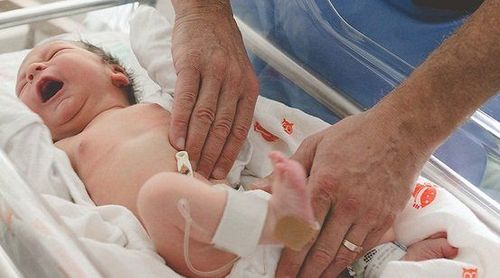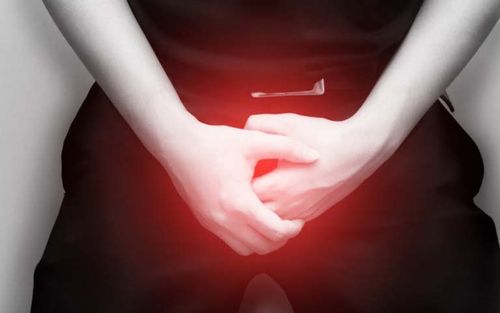This is an automatically translated article.
The article is written by MSc Nguyen Hung Cuong, Gastroenterologist, General Surgery Department - Vinmec Times City International General Hospital.
An inguinal hernia is a condition in which the viscera move out of its normal position through the body's natural weaknesses. Hernias can be congenital (born with) or acquired (accompanied during one's lifetime). The natural weak points are usually located in the inguinal region, mid-abdominal white line, navel area, so similarly we have inguinal hernias, mid-white line hernias, umbilical hernias.
1. What are the signs of an inguinal hernia?
These are signs that the patient can feel on their own, the specialized term is still called functional symptoms.
Seeing pain accompanied by a bulging mass in the groin area, initially the block only appears when there are activities that increase abdominal pressure such as: coughing, straining when defecating, running, jumping, ... Later on, the mass appears often more often, even when standing or walking. When lying at rest, the mass may flatten or disappear because then the viscera return to the abdomen, no longer located in the groin area. In young children, they may be fussy, irritable, uncomfortable, for older children or when bathing, they will see a bulge in the scrotum, groin in boys or the area near the labia in girls, the mass appears when the child cries, runs. dance, when lying down no longer appear.
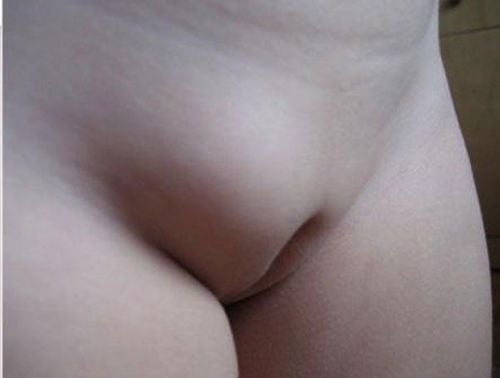
2. Physical Examination
The doctor's examination is recorded:Look: See a bulge located in the groin area, which can change in size when doing a stress test: coughing, pushing. Sometimes your doctor will tell you to jump in place about 10 times to make the hernia more visible. Palpation: The doctor will wear gloves to examine the hernia mass to see how dense the hernia mass is, whether there is tension or not. The doctor will use his finger to push along the path of the inguinal canal to feel the diameter of the hernia hole, then you will feel discomfort in the groin and testicles on the same side.
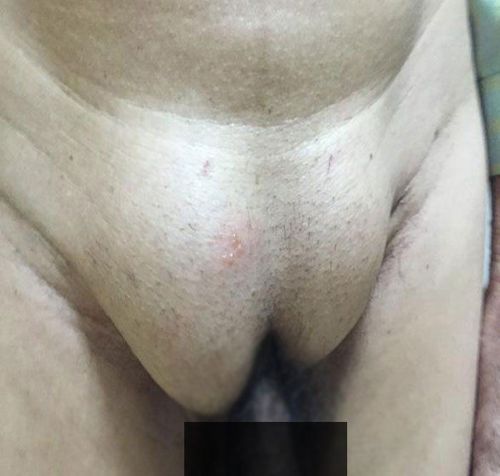
During the examination, the doctor will use a number of measures to evaluate the nature of the hernia mass as direct or indirect.
Flashlight: In some young children, a flashlight can be used in a dark room to see if the substance inside the bulge is fluid or other tissue such as intestines or intra-abdominal omental fat that has descended into the hernia capsule. Imagine when we look at the egg with a flashlight, the work does not cause you any pain. Today these manipulations are often ignored and replaced by ultrasound of the inguinal region.
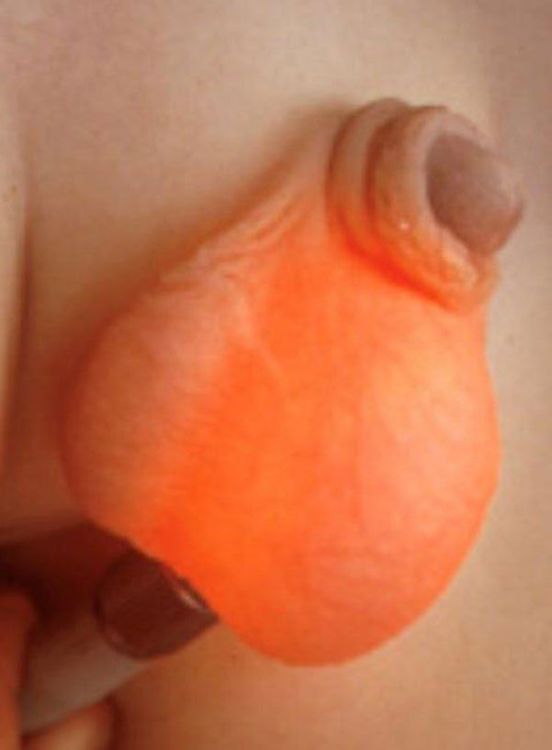
Ultrasound Ultrasound is a non-invasive subclinical examination that allows the diagnosis of inguinal hernia pathology. By inserting the ultrasound probe into the inguinal region, it is possible to see the hernia mass described in detail such as: diameter of the neck of the bag, the nature of the fluid in the bag, what is the content of the contents inside the bag, omental fat or bowel loops.
Diagnosis To confirm the diagnosis of inguinal hernia requires clinical examination and abdominal ultrasound, these are two indispensable components to make a conclusion whether you have an inguinal hernia.
In some cases, the above two examinations are not conclusive enough, doctors may appoint additional computed tomography of the abdomen for differential diagnosis with other diseases.
3. Distinguishing inguinal hernia from other pathologies
spermatic cord cyst: is a closed, fluid-filled sac structure located right next to the spermatic cord in the inguinal scrotum, ultrasound helps diagnose this pathology. Varicose veins: Feel the bulge as soft as velvet, the size does not change significantly even with increased intra-abdominal pressure (running, coughing, pushing). Vascular Doppler ultrasound evaluates the flow and does the Valsalva maneuver to determine the status of the varicocele. Testicular effusion: The mass usually appears in the lower part of the scrotum, the scrotal skin is tight but not swollen, and it is not hot to the touch. Flashlight and ultrasound to confirm the differential diagnosis.
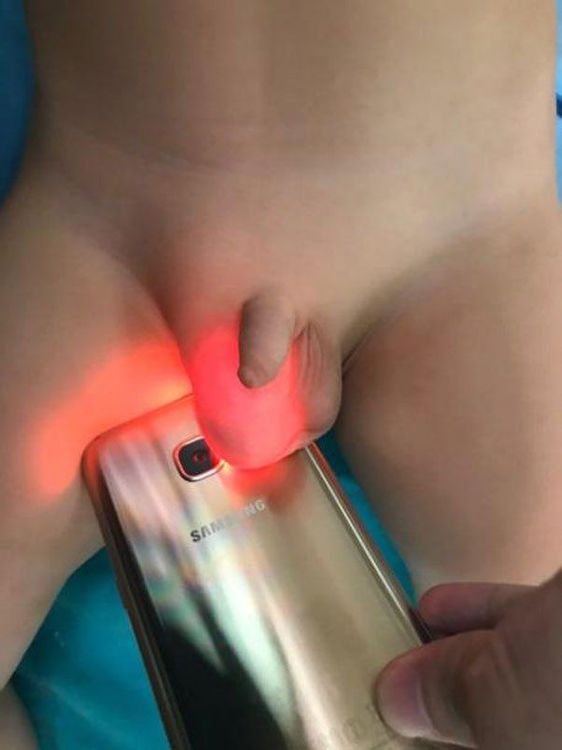
Testicular torsion Another emergency condition that needs to be distinguished between testicular torsion and strangulated inguinal hernia is:
Before that, it is often not seen that the mass descends into the scrotum. The testicle on the side with torsion is more painful, the testicle on the side of the torsion is usually higher than the opposite side. The scrotal skin is twisted and reddened. Prehn's test: Lifting the affected testicle is more painful than the other (positive Prehn's test). Doppler ultrasound assessment of the blood vessels of the spermatic cord helps confirm the diagnosis.
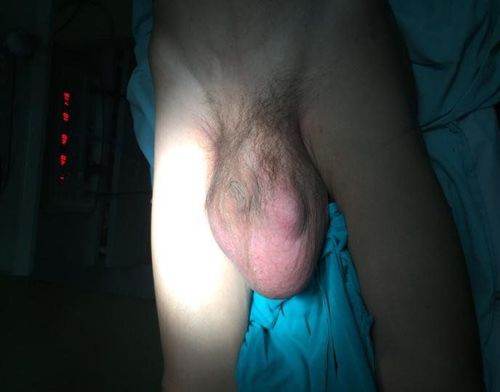
4. Progression to inguinal hernia
When encountering the above situation, it is necessary to visit a specialist immediately to take timely measures to prevent complications that may be encountered due to inguinal hernia.
Progression: If not treated in time, the hernia mass is getting bigger and bigger, the abdominal wall is getting weaker and weaker, the ability to repair and restore the weakness of the abdominal wall is increasingly difficult, the risk of recurrence after surgery will be high. than. Obstruction: This is a serious complication of inguinal hernia because the intra-abdominal component (intestine, omental fat) passes through the neck of the hernia sac without returning to the abdomen. Blood vessels are obstructed, causing anemia, rapid necrosis, intestinal rot, and peritonitis. The state of strangulation is shown: The inguinal hernia is tight, cannot be flattened, cannot be pushed back into the abdomen, the mass does not change in size even when lying down.
5. Inguinal hernia treatment
The treatment of inguinal hernia depends on the medical conditions of each local area, but on the principle of surgery to solve the disease thoroughly, prevent complications or inconveniences that this pathology brings.
With children
Children under 1 year old: Should be monitored until the child is 1 year old, if the hernia hole cannot close on its own, surgery will be performed. During the monitoring period, if there are complications of strangulation, they must go to a medical facility immediately for timely surgery. A frequently asked question is whether a scrotum or inguinal compression should be used: the answer is No. The reason is that prolonged compression can affect the maturation and function of the testicles of the child later in life. When the child is older than 1 year, but the hernia hole can not be closed by itself, the hernia block still exists, the problem of surgery should be raised as long as the medical facility has a pediatric surgeon or has experience in surgery. inguinal hernia surgery in children. The surgery for inguinal hernia in children only needs suturing to close the hernia sac, because the abdominal wall defect is not large, so the restoration of the abdominal wall is not necessary. However, the evaluation of this abdominal wall defect to decide whether to restore the weakness of the abdominal wall depends on the examination surgeon. 5.1 Open surgery A small incision is made in the base of the scrotum to access the hernia sac, the neck of the bag is tightened to prevent the abdominal viscera from descending.
5.2 Laparoscopic surgery The abdomen is inflated and inflated, under the view of the camera the surgeon can see the hernia hole, the hernia sac neck is sutured.
Depending on the surgeon's level, laparoscopic surgery is performed by 1 incision in the abdomen or 3 incisions.
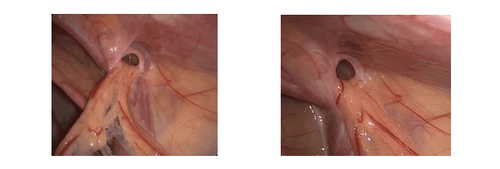
With adult adults
Hanging scrotum should only be applied to the following cases:
The patient is elderly and weak or has comorbidities that are not eligible for surgery Conditions medical facilities are unable to perform Currently having surgery Waiting to schedule appropriate surgery (in terms of time)

Surgery for inguinal hernia in adults, regardless of how it is approached (open surgery or laparoscopic surgery) must ensure two purposes:
First: Stitch the neck of the hernia sac Second: Restore the inguinal abdominal wall Yes There are many ways to divide the surgery in the treatment of inguinal hernia, for surgical specialties, it is often divided:
Stretch surgery – Restoration of the inguinal abdominal wall by autologous fascia, typical of the techniques This is the surgery of the authors Bassini, Shouldice, Marcy, Desarda, McVay. Weakness in the abdominal wall will be restored by suturing the surrounding muscle fascia, thus creating tension. Non-stretching surgery – Weaknesses of the inguinal wall are restored with mesh- this is an artificial material that is placed in place of the hernia opening so that the abdominal organs do not have a chance to come out. However, the term stretch or not stretch is sometimes confusing for patients, so we can approach it in a different way that is easier to imagine: Laparoscopic surgery and open surgery in the treatment of inguinal hernia.
Open surgery (Open surgery) A diagonal incision in the inguinal area helps the surgeon access the hernia sac, the neck is closed, then the abdominal wall is restored in 2 ways:
Using autologous materials are scales. muscles to restore the abdominal wall (Basini, MacVay, Shouldice...).
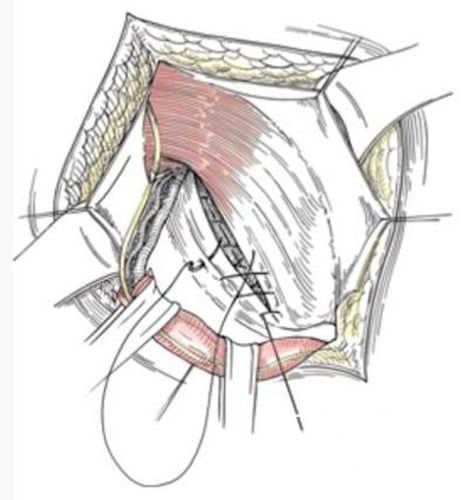
The advantage of this method is that it does not have to use artificial materials, so there is no risk of infection or rejection reaction of artificial materials. However, these methods make the inguinal region tight, uncomfortable, large surgical scars, so it is not aesthetic.
Using artificial material (Lichtenstein method) Weakness in the abdominal wall will be restored by placing an artificial mesh. The biggest advantage of this method is that it minimizes the risk of stretching the inguinal abdominal wall - this is a very uncomfortable feeling that can be experienced after surgery, but the disadvantage of this method is the risk of infection or digging. waste of the artificial mesh, because it is a foreign body introduced into the body.
Laparoscopic surgery Instead of an artificial mesh placed from the outside, the mesh is placed from the inside of the abdomen. There are 2 techniques to place the mesh by laparoscopic surgery
Surgical mesh placement from the inside of the abdominal wall that goes through the peritoneum – We often see the name TAPP surgery, which stands for transabdominal preperitoneal and surgery Place the mesh from the inside of the abdominal wall but not through the peritoneum - we often hear the name TEP - Total extra peritoneal surgery.
Basically these two surgeries both approach the weakness of the abdominal wall fascia from the inside, the hernia hole is "covered" with a mesh, over time that mesh will be as tough and firm as we pour. so concrete.
The difference between these two techniques is whether there is perforation of the peritoneum or not. As we all know, the peritoneum, also known as the peritoneum, is a thin membrane that contains the internal organs of the abdomen and lines the inside of the abdominal wall muscles. The peritoneum is always smooth, allowing the intestines and abdominal organs to slide up easily.
With the transperitoneal laparoscopic technique (TAPP technique), the peritoneum is perforated and flipped up, the mesh is placed in the right position of the hernia hole, then the peritoneum is lowered and sutured closed as before. For the TEP technique, the mesh is completely placed outside the peritoneum.
Description of laparoscopic transperitoneal mesh placement- TAPP technique.
The patient is placed supine, several small incisions are made (the number of incisions is usually 1 to depending on the surgeon's habits and qualifications).
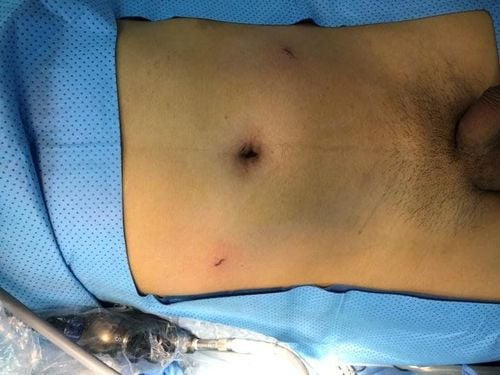
In the inflated abdomen, under the view of the camera, the doctor will see the hernia hole.
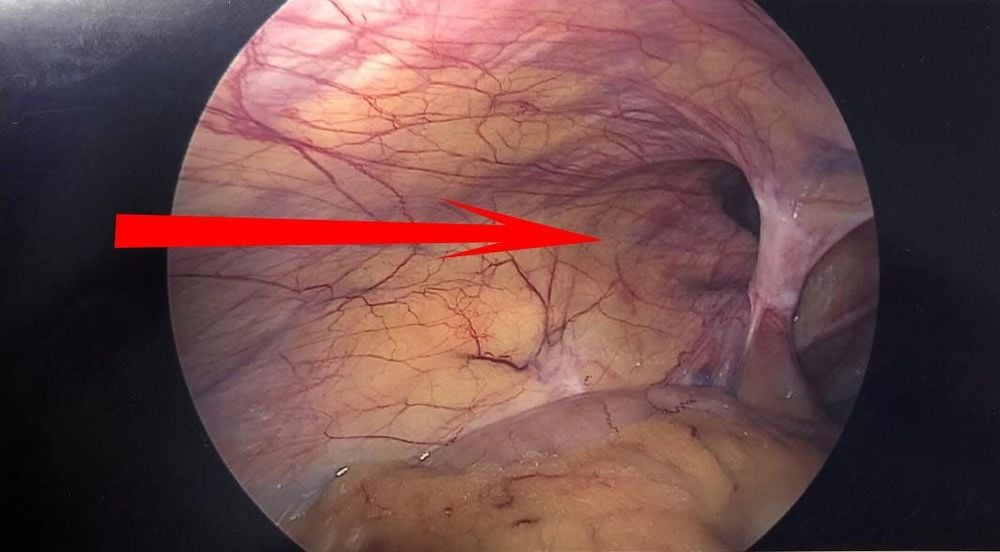
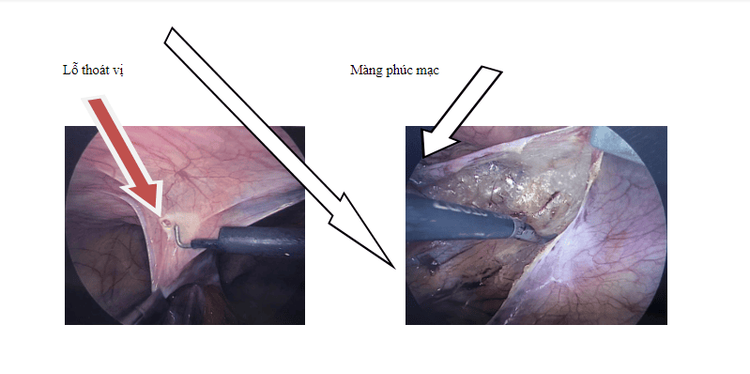
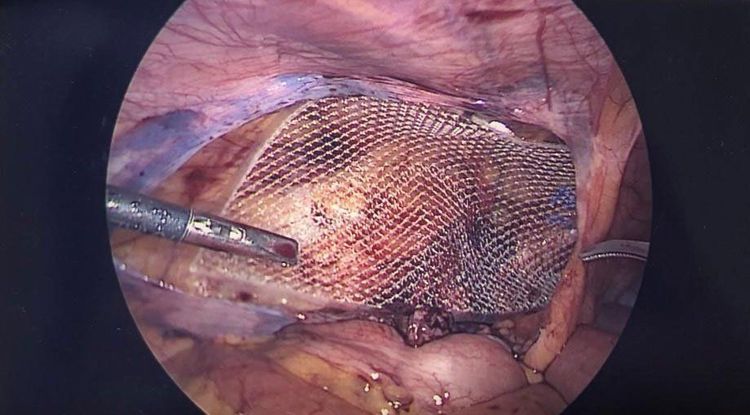
For flat mesh panels, to avoid displacement, the surgeon can sew, using metal pins to secure the mesh to the abdominal wall. Nowadays, manufacturers have made 3D mesh, which has a spatial structure that fits the hernia hole, so using this mesh can shorten the surgery time and the risks that the pin immobilizes. metal induced during and after surgery.
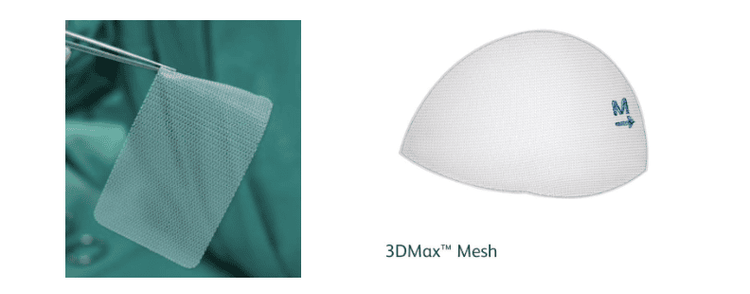
Then the peritoneal membrane is sewn closed to prevent the mesh from falling back into the abdomen and to ensure the inherent slippery nature of this membrane to the intra-abdominal organs.
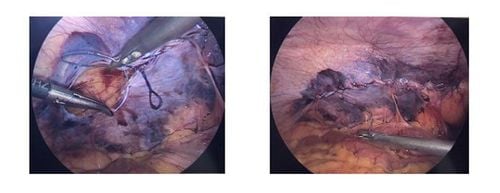
Then the peritoneal membrane is sewn closed to prevent the mesh from falling back into the abdomen and to ensure the inherent slippery nature of this membrane to the abdominal organs
6. Which surgery should be chosen to treat inguinal hernia in adults?
To treat inguinal hernias in adults, laparoscopic mesh placement is preferred for the following reasons:
After surgery, the patient has no (or very little) feeling of tightness and pain in the inguinal abdomen. Early postoperative recovery, short hospital stay Low chance of recurrence Can be done even with a history of inguinal hernia surgery (open surgery) or previous abdominal surgery. Less trauma, damage to surrounding organs High aesthetics
Who can perform laparoscopic surgery?
If you have an inguinal hernia, it is possible to perform laparoscopic surgery, except:
Suffering from severe cardiovascular and respiratory diseases Have had too many intra-abdominal surgeries Vinmec International General Hospital gathers a team of doctors, highly skilled and experienced, dedicated to the profession, especially proficient in each complicated surgical step of the laparoscopic method of treating inguinal hernia.
Vinmec Health System is equipped with modern and advanced facilities, international standard technical facilities, in addition, always ensures the close supervision of medical managers, will help patients Laparoscopic surgery for inguinal hernia treatment in children was carried out smoothly and safely.
Moreover, in the field of surgical surgery, Vinmec possesses a very good level of anesthesia, anesthesia and analgesia, useful for surgery participants such as children.
Please dial HOTLINE for more information or register for an appointment HERE. Download MyVinmec app to make appointments faster and to manage your bookings easily.







